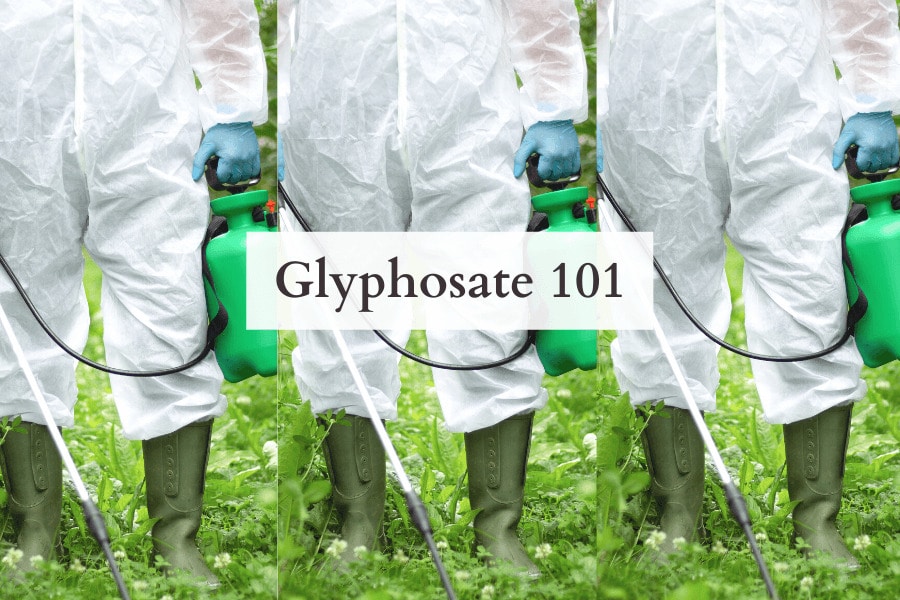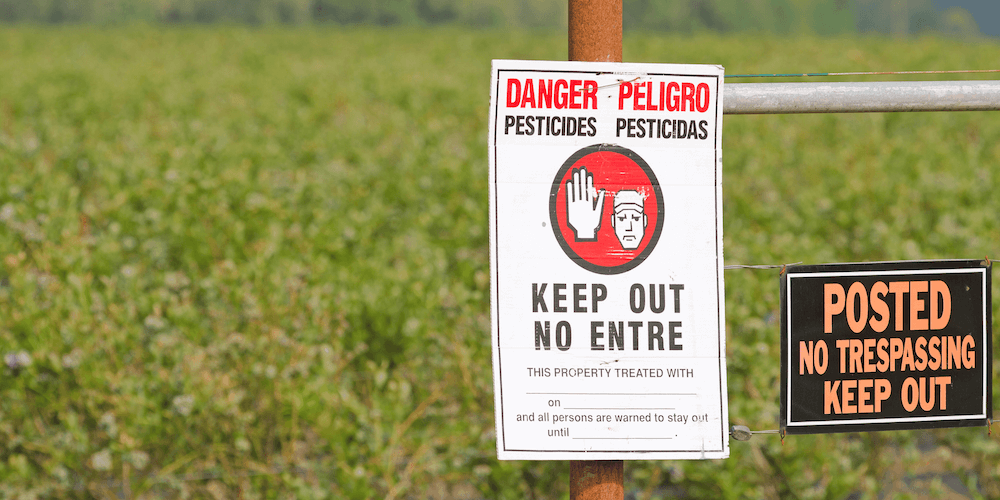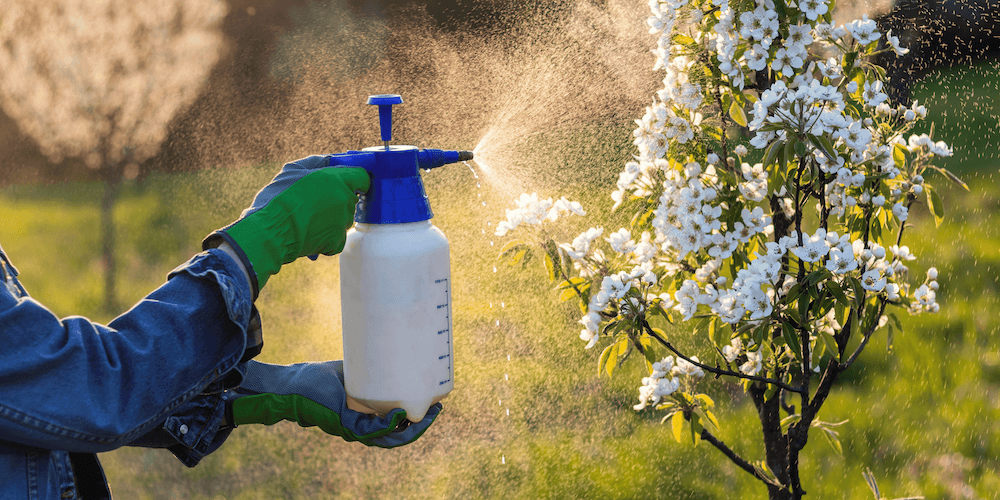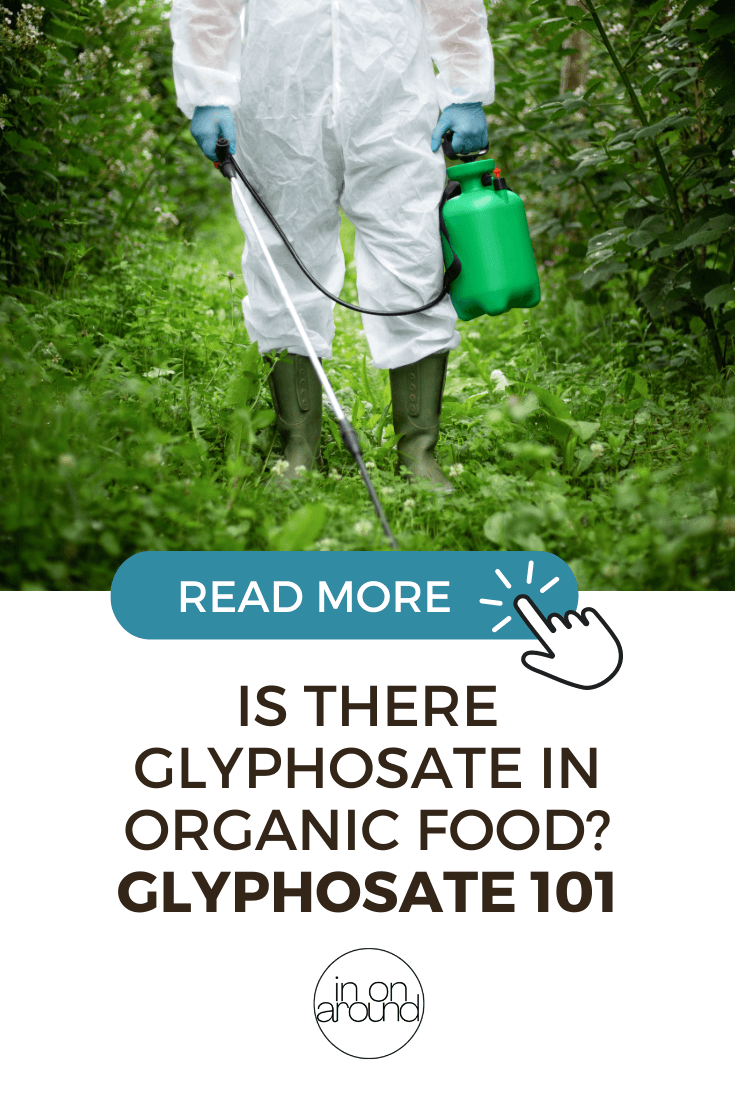Does one of the most widely used herbicides come with a side of chronic disease? Where is glyphosate used, why is it still being sold, what are the health risks, and how can you avoid it? Is it truly safe? Is glyphosate in organic food too?
Keep reading for the details (believe me… you’re going to want to know this).

(Note: This article contains affiliate links, meaning In On Around will make a small commission at no additional cost to you. This helps me maintain the site. As always, I value full transparency & only work with brands I love and trust.)
What Is Glyphosate?
Glyphosate is the active ingredient found in Monsanto’s RoundUp herbicide spray. It’s the most widely used herbicide in the United States & around the world. In fact, according to the Environmental Protection Agency, about 280 million pounds are applied “to an average of 298 million acres of cropland annually” in the USA alone – that’s a lot of herbicide.
Glyphosate is widely used for agricultural purposes, as well as for lawn care, garden care, and forest management. Many households have bought RoundUp spray to kill weeds or control weeds that naturally pop up around their yards. It’s one of the most popular weed killers on the market. It’s especially used on some genetically modified/GM crops, however, some RoundUp ready crops are herbicide-resistant to RoundUp (also known as RoundUp tolerant, GM herbicide-tolerant crops, glyphosate-resistant crops or glyphosate-tolerant).
About 280 million pounds of glyphosate are applied to cropland annually.
Who Is The Monsanto Company?
Monsanto is an American agrochemical and agricultural biotechnology company that was founded in 1901. With a net worth of over $65 Billion (yes, with a B), they are one of the leading producers of biochemical products. In 2018, they were officially acquired by one of the largest pharmaceutical companies in the world, Bayer.
Monsanto has been involved in numerous scandals, from ghost-writing scientific studies… to colluding with herbicide reviews. High-level executive emails were even leaked saying they wanted to “beat the sh** out of” “dumb mothers” who were concerned about glyphosate’s health hazards. Classy. Proof of these emails can be found here.
There are well over 125,000+ Monsanto GMO lawsuits from all over the world. Bayer announced that they are paying $10+ billion to settle, however, their products are still being used around the world.

So What’s The Big Deal?
Products on the market, especially chemicals sprayed on food, should be extremely safe. According to many scientific studies, this is not the case with glyphosate. Monsanto Bayer, and our world leaders, are experimenting with our health. The chemical is so highly sprayed that it has been found in 75% of air and rain samples – this is outrageous. Many weeds, plants (like GM crops or pest resistant crops) & even bacteria have grown to be resistant to the chemical since it’s so prevalent. This certainly does not help us in the fight against antimicrobial resistance.
Just last November 2020, the EPA released a biological evaluation showing that glyphosate is likely to injure or kill about 93% of endangered plants and animals (about 1676 species). [1] For this environmental health reason alone, why is it not being banned!? Products with glyphosate are serious environmental pollutants.
The use of this toxic chemical and dangerous pesticide must come to an end now. The human health impact and environmental impact are astonishing.
Glyphosate is likely to injure or kill 93% of endangered plants & animals.
How Does Glyphosate Impact Our Health?
Where do we even begin? While the EPA and Monsanto Bayer claim that the product is safe, many scientific studies claim otherwise.
Glyphosate has been potentially linked to a wide range of health issues, such as:
- DNA damage that can lead to cancer, such as Non-Hodgkins Lymphoma [2]
- Endocrine disruption [3]
- Parkinson’s Disease [4]
- Leaky gut [5]
- Reproduction issues [6]
- Alzheimer’s Disease [7]
- Significant disruption of gut bacteria [8]
- Liver & kidney damage [9, 10, 11]
… and many, many more.
The International Agency for Research on Cancer (which is part of the World Health Organization) said that glyphosate is “probably carcinogenic to humans” in March of 2015. [12] Monsanto retaliated by spending over $17 million on a pro-glyphosate marketing ploy to try to “discredit” the study. [13]
Glyphosate may increase cancer risk by 41%.
One University of Washington study published in 2019 even shows that it can increase cancer risk by 41%! [14] Wow. High levels of pesticides and herbicides contaminate our food supply (even found in cereals marketed toward children), and it runs off into our drinking water supply, streams, and lakes. [15]
We’ve seen a continuous increase in chronic disease since its introduction into the food supply. For instance, 80% of children in areas of Argentina, which heavily use glyphosate, have traces of the herbicide in their blood. [16] Their communities are troubled with dramatic increases in widespread cancer, birth defects, chronic illness from endocrine disruptors, and other adverse effects.
Glyphosate was found in the urine of 93% of Americans tested. [17]
Why Is Glyphosate Still Being Sold?!
With evidence continuing to be compiled that proves the dangers of glyphosate, the EPA has yet to change its stance. They’ve re-approved its use time and time again. The EPA refuses to acknowledge these risks… in fact saying that they “did not indicate the need for additional testing for glyphosate.” [18]
Widespread change is needed! This is a public health crisis.
Thankfully, a limited number of US counties have banned or restricted the use of glyphosate. [19] While these are certainly steps in the right direction, they’re a needle in the haystack. Wide-spread regulatory change is needed to end the use of glyphosate in over 750 products throughout the US.
With money, comes power… and Monsanto has the EPA wrapped around its fingers. EPA – it’s time to step up and ban the use of this toxic herbicide country-wide.

How Can You Limit Glyphosate Exposure?
While it’s nearly impossible to 100% remove this chemical from your life, there are definitely simple steps you can take to reduce your exposure. Decreasing chronic exposures is key.
- Buy certified organic, especially from local farms. Vote with your dollar and support the farmers who are not spraying produce with this toxin. Organic farmers cannot use glyphosate at any point in the food production lifecycle.
- This will also help to decrease your exposure to many other potentially harmful pesticides and herbicides (some of which are used as a crop desiccant, meaning agricultural products/food products are sprayed pre harvest).
- … But is glyphosate in organic food? There still may be some glyphosate residue on organic produce (unless it is certified Glyphosate-Free). This is mainly due to run off and pesticide/herbicide drift between farms. The amount of glyphosate on organic crops is significantly less than non-organic produce. Eating an organic diet can help you reduce exposure to higher-levels of toxic chemicals.
- Eat predominantely plant-based. Factory-farmed animals are fed & fattened up on glyphosate-sprayed corn & soy, which accumulate in the body. Support your body with high-quality fruits and vegetables.
- If you do eat animal products, opt for pasture-raised, grass-fed, and organic. High quality is key!
- Use a high-quality water filter (my favorite is AquaTru)
- You can learn more about water purifiers here: What To Look For In A Water Filter or Purifier
- Wash your produce thoroughly
- You can learn more about proper washing techniques here: Complete Guide To Safely & Properly Clean Fresh Produce
- Support your gut health (like with fermented foods and probiotic supplementation)
- Incorporate bone broth. Learn more about that here: The Healing Benefits Of Bone Broth For Gut Health
- Avoid genetically modified crops (GE crops), including low-quality vegetable oils, which are high offenders for glyphosate contamination. GMO or genetically engineered crops (like corn, oats, soybeans & wheat) are the most highly sprayed.
- You can learn more about GMOs here: 13 Pros And Cons Of GMOs (Backed By Evidence)
- Don’t use RoundUp at home
- Instead opt for more natural weed-killing methods, such as vinegar or Sunday natural herbicide.
- Avoid recently pesticide-treated or herbicide-treated areas.
- If possible, avoid parks, sports fields, and playgrounds that have been treated with the chemical or have had recent pesticide applications.
- Support your detox pathways (like with a sauna), especially if you’ve recently been exposed to glyphosate.
- It’s essential to reduce urinary levels as much as possible.
- To learn more about saunas, check out: Sauna Health Benefits & Who Should Not Use A Sauna
- If you can, grow your own produce!
- Fresh produce is rich in important minerals too.
- Have a “no shoes” policy in your home to limit bringing glyphosate residues inside.
Save this image on Pinterest for future reference:

Frequently Asked Questions
Click on the below FAQs to learn more about the potential health effects caused by glyphosate. The daily intake of glyphosate-based herbicide residues can lead to toxic effects on human health, especially related to the shikimate pathway, human cells, oxidative stress, and other health problems. The long-term effects of glyphosate are still being studied in independent research around the globe. Reduce your glyphosate level as much as possible.
What is glyphosate?
Who is Monsanto?
How does glyphosate impact my health?
How can I reduce glyphosate exposure?
What are your thoughts on glyphosate?
How will you reduce your exposure long term?
Let me know your thoughts below in the comments!
xoxo,

Want to read more? Check out my other articles here!
Information on Glyphosate & Glyphosate In Organic Food from: FDA, USDA (Department of Agriculture), The Guardian, HuffPost, MD Daily, RoundUp, EWG, NPR, NY Times, GMO Free, Forbes, Biological Diversity, NPIC, EcoWatch, LongReads, Alex Fergus, Only Organic, Detox Project
Copyright In On Around LLC 2021 © The statements made on this website have not been evaluated by the FDA (U.S. Food & Drug Administration). They are not intended to diagnose, treat, cure, or prevent any disease. The information provided by this website should not be used as individual medical advice and you should always consult your doctor for individual recommendations and treatment. I do not make any warranties on the completeness, reliability, and accuracy of this information. Any action you take upon the information on this website is strictly at your own risk.
I will not be liable for any losses and damages in connection with the use of this website. In On Around is not responsible for any errors or omissions. All views on this site are my own and do not represent the opinions of any entity whatsoever with which I have been, am now, or will be affiliated. See disclaimer for more.



